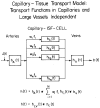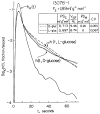Cellular influx and efflux in the heart
Abstract
Techniques for estimating cellular uptake rates of substrates are now developed to the point where they can be used in a research setting. They are based on the use of the multiple indicator dilution technique, in which intravascular and extravascular reference tracer solutes are used simultaneously with the tracer substrate. The analysis involves fitting the dilution curves with mathematical models accounting for flow (and its regional variation), capillary permeation, dilution in the interstitial space, penetration of the sarcolemma of myocardial cells, and dilution and consumption inside the cells. The same principles and models are applicable to data in the form of externally detected residue function curves of the organ’s content of tracer as are suited to coronary sinus outflow concentration-time curves. The future developments will be in refining the external detection techniques, in making the studies less invasive and more suited to clinical studies. Multiple gamma photon imaging may be more useful than positron imaging for such studies because of the need to use simultaneous sets of tracers, including appropriate intravascular and extracellular references.
Figures




References
Publication types
MeSH terms
Substances
Grants and funding
LinkOut - more resources
Full Text Sources
